A Structural Model for Aggression in Middle School Students in Korea: Based on Ajzen’s Theory of Planned Behavior
Abstract
1. Introduction
1.1. The Necessity of Research
1.2. Research Purpose
1.3. Conceptual Framework
2. Materials and Methods
2.1. Research Design
2.2. Research Participants
2.3. Research Measurement Tools
2.3.1. Parenting Behavior Perceived by Children
2.3.2. Attitudes toward Aggression Regulation Behavior
2.3.3. Subjective Norms for Aggression Regulation Behavior
2.3.4. Perceived Behavioral Control for Aggression Regulation Behavior
2.3.5. Difficulties in Emotion Regulation
2.3.6. Aggression Regulation Intention
2.3.7. Aggression
2.4. Data Collection Methods and Ethical Considerations
2.5. Data Analysis Method
3. Results
3.1. Subject Characteristics
3.2. Descriptive Statistics and Confirmatory Factor Analysis of the Research Variables
3.3. Verification of the Structural Model of Middle School Students’ Aggression
3.3.1. Validation of the Hypothetical Model
3.3.2. Estimating the Parameters of the Model and Analyzing the Effects
4. Discussion
4.1. Parenting Behavior and Difficulties in Emotion Regulation
4.2. Aggression Regulation Intention and Aggression Based on the TPB
4.3. Research Implications
4.3.1. Theoretical Aspects
4.3.2. Research Aspects
4.3.3. Estimating the Parameters of the Model and Analyzing the Effects
4.4. Limitations of the Research
5. Conclusions
5.1. Conclusions
5.2. Suggestions
Author Contributions
Funding
Institutional Review Board Statement
Informed Consent Statement
Data Availability Statement
Conflicts of Interest
References
- Heo, J.Y.; Lee, K.H. The moderating effects of autonomy on the relationship between academic stress and aggressive inclination. Korean J. Sch. Psychol. 2013, 10, 429–448. [Google Scholar] [CrossRef]
- Jung, H.W.; Oh, S.D. The Difference between aggression and impulsiveness according to the state of the internet addictionof a vocational high school students in a rural area. Korea J. Couns. 2008, 9, 601–614. [Google Scholar] [CrossRef]
- Choi, J.W.; Jo, E.Y. The effects of parental abuse and peer attachment on aggression amongst children using community child centers: An application of latent growth modelling. Stud. Korean Youth 2020, 31, 33–52. [Google Scholar] [CrossRef]
- Farrell, A.D.; Sullivan, T.N.; Esposito, L.E.; Meyer, A.L.; Valois, R.F. A latent growth curve analysis of the structure of aggression, drug use, and delinquent behaviors and their Interrelations over time in urban and rural adolescents. J. Res. Adolesc. 2005, 15, 179–204. [Google Scholar] [CrossRef]
- Huesmann, L.R.; Dubow, E.F.; Boxer, P. Continuity of aggression from childhood to early adulthood as a predictor of life outcomes: Implications for the adolescent-limited and life-course-persistent models. Aggress. Behav. 2009, 35, 136–149. [Google Scholar] [CrossRef]
- Lee, D.Y.; Kim, J.C. Identifying latent classes and search on predicting factors about the changing trajectory of youth′ delinquency. Korean J. Youth Stud. 2019, 26, 227–251. [Google Scholar] [CrossRef]
- Lee, H.J.; Wi, S.A.; Kim, B.J. A study of aggression and delinquent behavior-focusing on gender difference and change. Korean J. Woman Psychol. 2015, 20, 675–695. [Google Scholar] [CrossRef]
- Hong, M.S.; Eo, J.K. The effects of narcissism, empathy ability and self esteem on middle school students’ aggression according to the sex. Korea J. Couns. 2013, 14, 3911–3928. [Google Scholar] [CrossRef]
- Park, M.J.; Choi, B.G. The ecological variables on adolescent relational aggression. J. Korean Home Manag. Assoc. 2004, 22, 95–104. [Google Scholar]
- Lee, E.S. Parent’s psychological control has an effect on teenagers’s relational aggression: Mediating effects of emotion regulation. J. Emot. Behav. Disord. 2017, 33, 111–131. [Google Scholar] [CrossRef]
- Park, S.M.; Im, J.H. Relational aggression during adolescence: A systematic review of personal and environmental factors from published articles in South Korea. Korean J. Hum. Dev. 2021, 28, 93–117. [Google Scholar] [CrossRef]
- Park, K.W.; Kang, H.W. An analysis of structural relationships of aggression on social support, self-efficacy, adaption of school life during sport club activities in school of adolescent. J. Korean Soc. Sci. 2016, 25, 397–411. [Google Scholar]
- Kim, S.H.; Kim, H.M. Effects of parental child-rearing attitudes on adolescents’ aggressiveness: Mediation effects of peer attachment. J. Korea Contents Assoc. 2018, 18, 642–651. [Google Scholar] [CrossRef]
- Gratz, K.L.; Roemer, L. Multidimensional assessment of emotion regulation and dysregulation development, factor structure, and initial validation of the difficulties in emotion regulation scale. J. Psychopathol. Behav. Assess. 2004, 26, 41–54. [Google Scholar] [CrossRef]
- Gaussen, T. Handbook of Child Psychology: Fifth Edition, Vol. Three: Social, Emotional and Personality Development. J. Child Psychol. Psychiatry Allied Discip. 2001, 42, 839–842. [Google Scholar] [CrossRef]
- Önder, F.C.C.Ö. Ergenlerde Saldırganlık: Duygu Düzenleme ve Duygusal Başa Çıkmanın Rolü. Kast. Educ. J. 2020, 28, 1198. [Google Scholar] [CrossRef]
- Anatolij, N.A.L.R. Factors That Cause Aggressive Behavior in Adolescents. Развитие Образoвания 2019, 46, 87. [Google Scholar] [CrossRef]
- ZinatMotlagh, F.; Ataee, M.; Jalilian, F.; MirzaeiAlavijeh, M.; Aghaei, A.; Shirazi, K.K. Predicting Aggression among Male Adolescents: An Application of the Theory of Planned Behavior. Health Promot. Perspect. 2013, 3, 269. [Google Scholar] [CrossRef]
- Ajzen, I. Theories of cognitive self-regulation the theory of planned behavior. Organ. Behav. Hum. Decis. Process. 1991, 50, 179–211. [Google Scholar] [CrossRef]
- Jang, S.; Ahn, H.Y. Development of the aggression regulation behavior scale for adolescent: Based on Ajzen’s theory of planned behavior. J. Korean Soc. Sch. Community Health Educ. 2020, 21, 39–57. [Google Scholar] [CrossRef]
- Suzanne, K.S. The Cycle of Violence: Assertive, Aggressive, and Abusive Family Interaction; Praeger: Oxford, UK, 1978; Volume 7, p. 675. [Google Scholar]
- Lee, K.Y.; Jeong, J.Y. A study on the difference in perception of health beliefs in nature-based tourism depending on the COVID-19 period: Application of the health belief model and theory of planned behavior. J. Tour. Sci. 2022, 46, 113–136. [Google Scholar] [CrossRef]
- Adams, C.; Gringart, E.; Strobel, N. Explaining adults’ mental health help-seeking through the lens of the theory of planned behavior: A scoping review. Syst. Rev. 2022, 11, 160. [Google Scholar] [CrossRef] [PubMed]
- Jeong, H.B.; Chae, J.S. Comparison of sports participation behavior before and after the COVID-19 pandemic by the planned behavior theory model. Korean J. Sport 2022, 20, 403–411. [Google Scholar] [CrossRef]
- Jang, H.Y.; Lee, S.S. A test of extended theory of planned behavior for explanation of illegal downloading and illegal uploading. Korean Crim. Psychol. Rev. 2022, 18, 99–114. [Google Scholar] [CrossRef]
- Lee, K.E.; Jeong, S.H. Predictors of cyberbullying behaviors among adolescents: Application of theory of planned behavior and social learning theory. J. Cybercommun. Acad. Soc. 2014, 31, 129–162. [Google Scholar]
- Gu, H.M.; Jeong, J.Y. Understanding the Intention of sex tourism using extended theory of planned behavior: A focus on the roles of perception and prior knowledge of prostitution. J. Tour. Sci. 2021, 45, 145–169. [Google Scholar] [CrossRef]
- Jo, H.I. Prediction of aggression of college athletes: An application of the theory of planned behavior. J. Korean Soc. Sci. 2016, 25, 325–337. [Google Scholar]
- Lee, S.H.; Kim, M.K.; Hong, E.Y.; Lee, J.J.; Kim, H.J.; Kim, H.S.; Kim, D.H.; Park, R.H.; Ban, J.Y.; Park, M.H.; et al. Structural equation modeling on spiritual nursing care of clinical nurses based on the theory of planned behavior. J. Korean Acad. Soc. Adult Nurs. 2022, 34, 27–38. [Google Scholar] [CrossRef]
- Lee, J.G.; Woo, H.J.; Lee, H.H.; Park, S.B.; Kim, D.G.; Choi, M.Y.; Kim, H.E.; Geum, H.S.; Jung, E.J.; Park, S.S. Theory of Planned Behavior, Understanding Media and Audience; Communication Books: Seoul, Republic of Korea, 2013. [Google Scholar]
- McLaughlin, K.A.; Zeanah, C.H.; Fox, N.A.; Nelson, C.A. Attachment security as a mechanism linking foster care placement to improved mental health outcomes in previously institutionalized children. J. Child Psychol. Psychiatry 2012, 53, 46–55. [Google Scholar] [CrossRef]
- Shin, J.Y.; Lee, Y.A.; Lee, K.H. The effects of life meaning and emotional regulation strategies on psychological well-being of Korean adolescents. Korean J. Couns. Psychother. 2005, 17, 1035–1057. [Google Scholar]
- Moon, Y.J.; Jwa, H.S. The effect of academic stress on psychological health in adolescents—Moderating effect of emotional regulation. Korean J. Soc. Welf. Stud. 2008, 38, 353–379. [Google Scholar] [CrossRef]
- Jang, S.; Ahn, H.Y. Development of an aggression scale for adolescents: Based on Ajzen’s theory of planned behavior. Child Health Nurs. Res. 2018, 24, 484–495. [Google Scholar] [CrossRef]
- Kim, M.S.; Oh, H.S. The relation among mother’s temperament, depression, parenting attitude and child′s character. Korean Soc. Woman Psychol. 2015, 20, 513–530. [Google Scholar] [CrossRef]
- Chyung, Y.J.; Darling, N. Varying association between peer problem behavior and adolescent problem behavior as a function of parental rule obedience. Fam. Environ. Res. 2003, 41, 1–11. [Google Scholar]
- Lee, S.Y. The effect of parenting attitude and parenting behavior on children’s self-efficacy as perceived by children. J. Korean Home Manag. Assoc. 2006, 24, 61–71. [Google Scholar]
- Lee, D.K.; Yeom, S.C. Multiple mediated effects of ego-resiliency and depression in the relation between the affectionate parenting attitude and aggression. Korea J. Youth Couns. 2015, 23, 277–298. [Google Scholar] [CrossRef]
- Jo, H.Y.; Park, J.W.; Chun, S.W. How do smokers′ emotion regulation strategies moderate the effects of cigarette graphic warnings on intentions to quit. J. Consum. Stud. 2018, 29, 157–178. [Google Scholar] [CrossRef]
- Bae, B.R. Structural Equation Modeling with Amos 27; Cheonglam: Seoul, Republic of Korea, 2021. [Google Scholar]
- Baumrind, D.; Black, A.E. Socialization practices associated with dimensions of competence in preschool boys and girls. Child Dev. 1967, 38, 291–327. [Google Scholar] [CrossRef]
- Park, S.Y.; Kim, J.S. Maternal traditional-Modern values, childrearing practices and children’s social behaviors. Korean J. Child Stud. 1997, 18, 125–142. [Google Scholar]
- Barber, B.K.; Olsen, J.A. Socialization in context: Connection, regulation, and autonomy in the family, school, and neighborhood, and with peers. J. Adolesc. Res. 1997, 12, 287–315. [Google Scholar] [CrossRef]
- Kim, H.Y. A study of the influences of parenting behavior perceived by the early youth on their psychosocial maladaptation. Korean J. Soc. Welf. Conf. 2000, 2000, 205–223. [Google Scholar]
- Ha, M.S.; Kim, J.H. The validation of the korean peer conflict scale(K-PCS) for use with young adolescents. Stud. Korean Youth 2013, 24, 71–101. [Google Scholar]
- Marsee, M.A.; Kimonis, E.R.; Frick, P.J. Peer Conflict Scale (PCS). APA PsycTests Dataset [Internet], University of New Orleans 2004. Available online: https://doi.org/10.1037/t06331-000 (accessed on 1 September 2022). [CrossRef]
- Park, J.S. Measurement of difficulty in controlling youth’s emotions-Psychological properties of DERS. Korean J. Health Psychol. 2013, 18, 727–746. [Google Scholar]
- Hart, C.H.; Nelson, D.A.; Robinson, C.C.; Olsen, S.F.; McNeilly-Choque, M.K.; Porter, C.L.; McKee, T.R. Russian parenting styles and family processes: Linkages with subtypes of victimization and aggression. In Family and Peers: Linking Two Social Worlds; Praeger series in applied psychology; Praeger Publishers/Greenwood Publishing Group: Westport, CT, USA, 2000; pp. 47–84. [Google Scholar]
- Jung, M.H. Effects of emotional control factors on aggressiveness in adolescents: Focusing on the mediating effect of stress coping method. Korean J. Youth Stud. 2017, 24, 205–229. [Google Scholar] [CrossRef]
- Kim, H.A.; Jang, H.I. The effects of paternal psychological control and father-child attachment on aggression: The mediating effects of emotional regulation. Korean J. Dev. Psychol. 2016, 29, 253–275. [Google Scholar]
- Kim, J.H. Effects of aggressive PC-game playing, aggressive traits, and self-efficacy on aggressive intention and aggressive behavior. J. Inst. Soc. Sci. 2001, 12, 61–78. [Google Scholar]
- Hagger, M.S.; Chatzisarantis, N.L.D.; Biddle, S.J.H. A meta-analytic review of the theories of reasoned action and planned behavior in physical activity: Predictive validity and the contribution of additional variables. J. Sport Exerc. Psychol. 2002, 24, 3–32. [Google Scholar] [CrossRef]
- Kim, E.A.; Choi, S.E. Structural equation modeling on living and brain death organ donation intention in nursing students. J. Korean Acad. Nurs. 2015, 45, 802–811. [Google Scholar] [CrossRef]
- Nigg, C.R.; Lippke, S.; Maddock, J.E. Factorial invariance of the theory of planned behavior applied to physical activity across gender, age, and ethnic groups. Psychol. Sport Exerc. 2009, 10, 219–225. [Google Scholar] [CrossRef]
- Buss, A.H.; Perry, M. The aggression questionnaire. J. Personal. Soc. Psychol. 1992, 63, 452–459. [Google Scholar] [CrossRef]
- Son, Y.K.; Lee, B.K. An efficacy of social cognitive behavior model based on the theory of planned behavior: A meta-analytic review. Korean J. Journal. Commun. Stud. 2012, 56, 127–161. [Google Scholar]
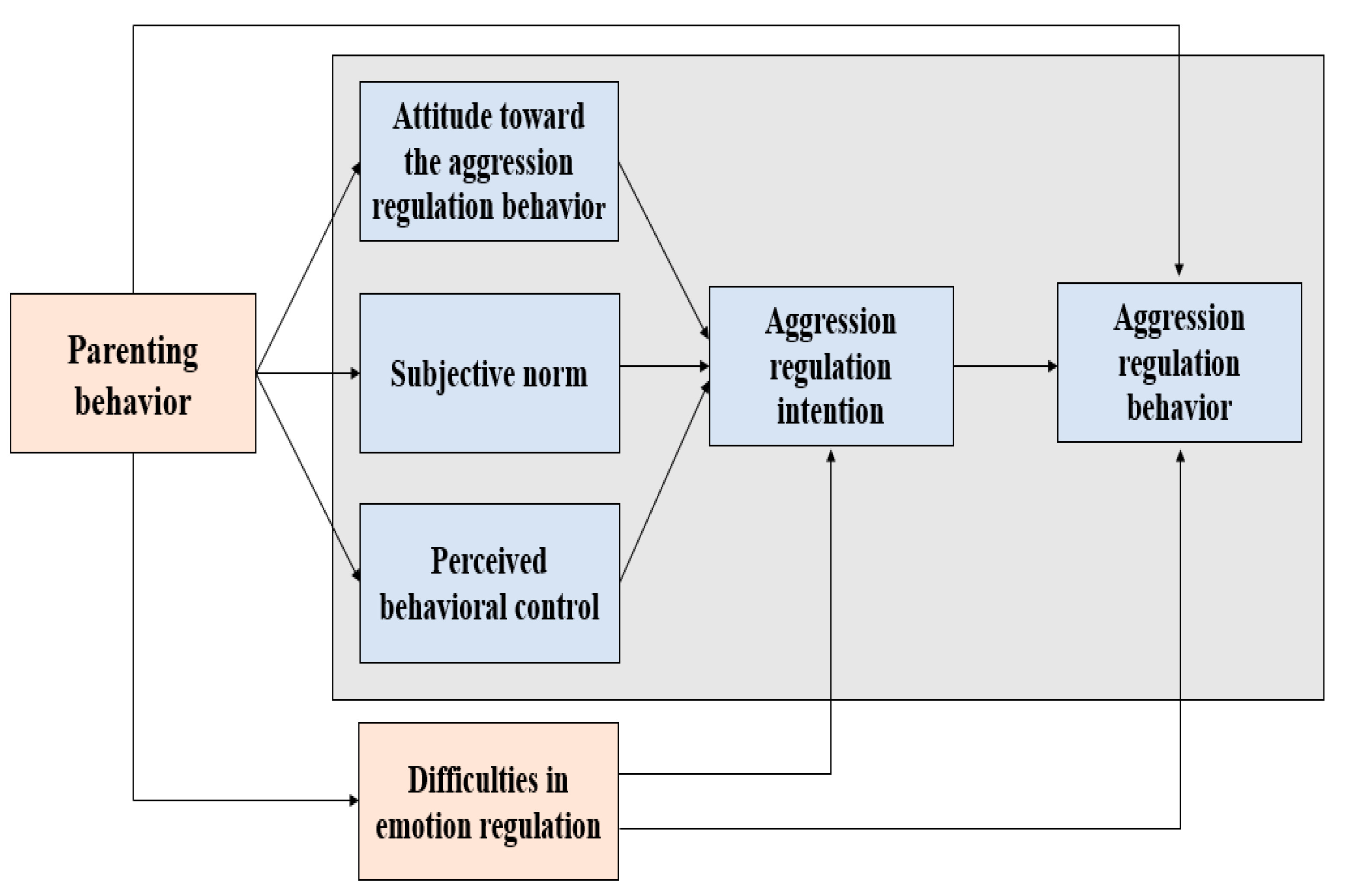
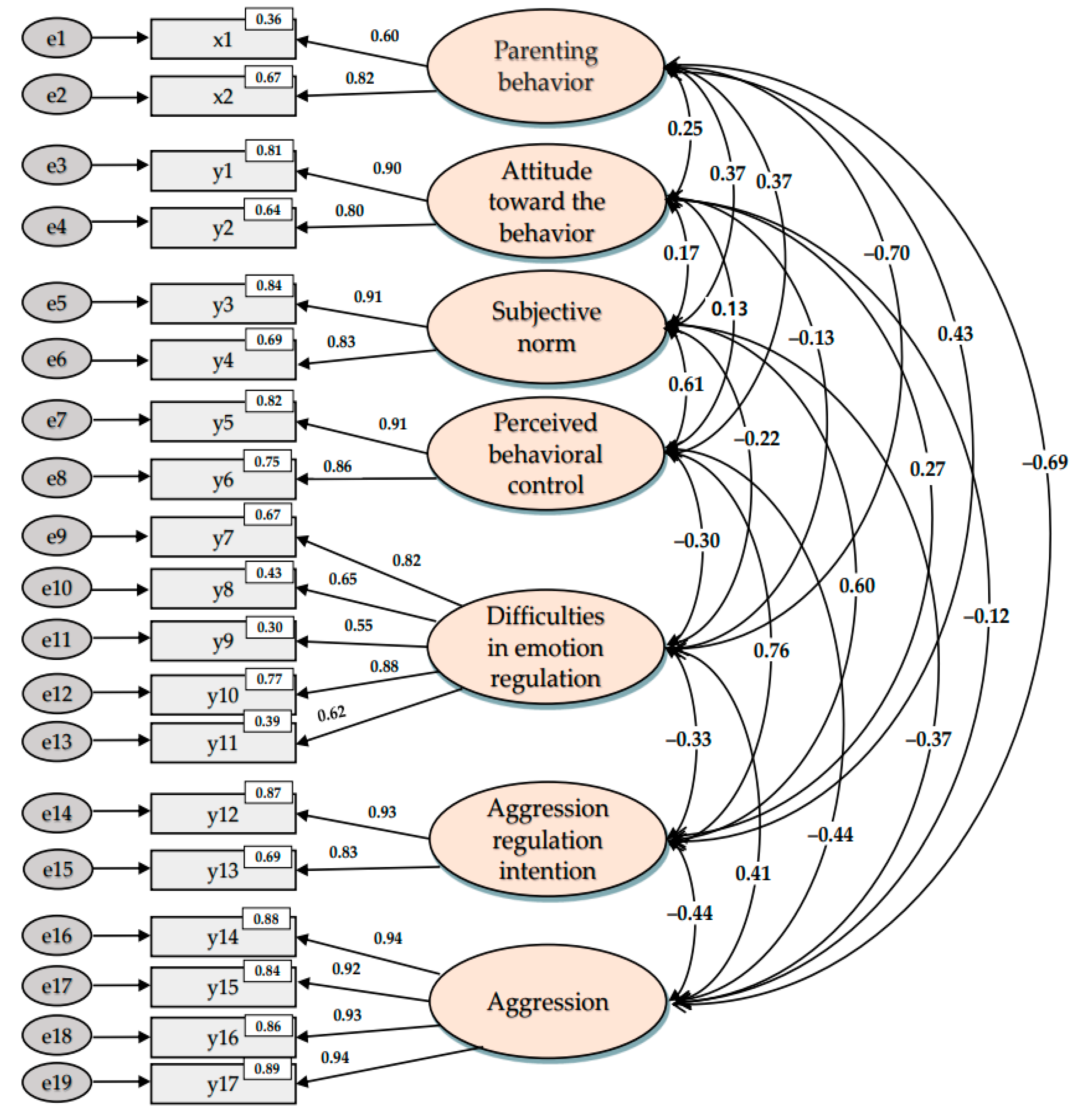
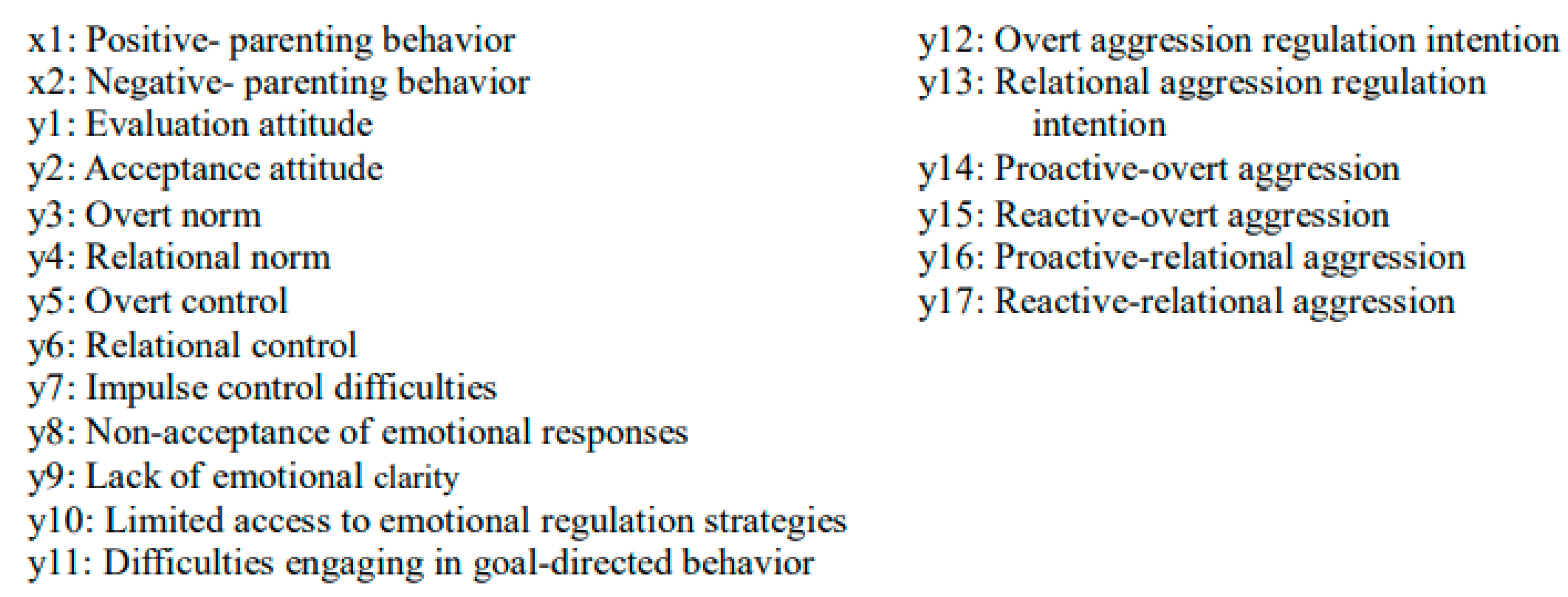
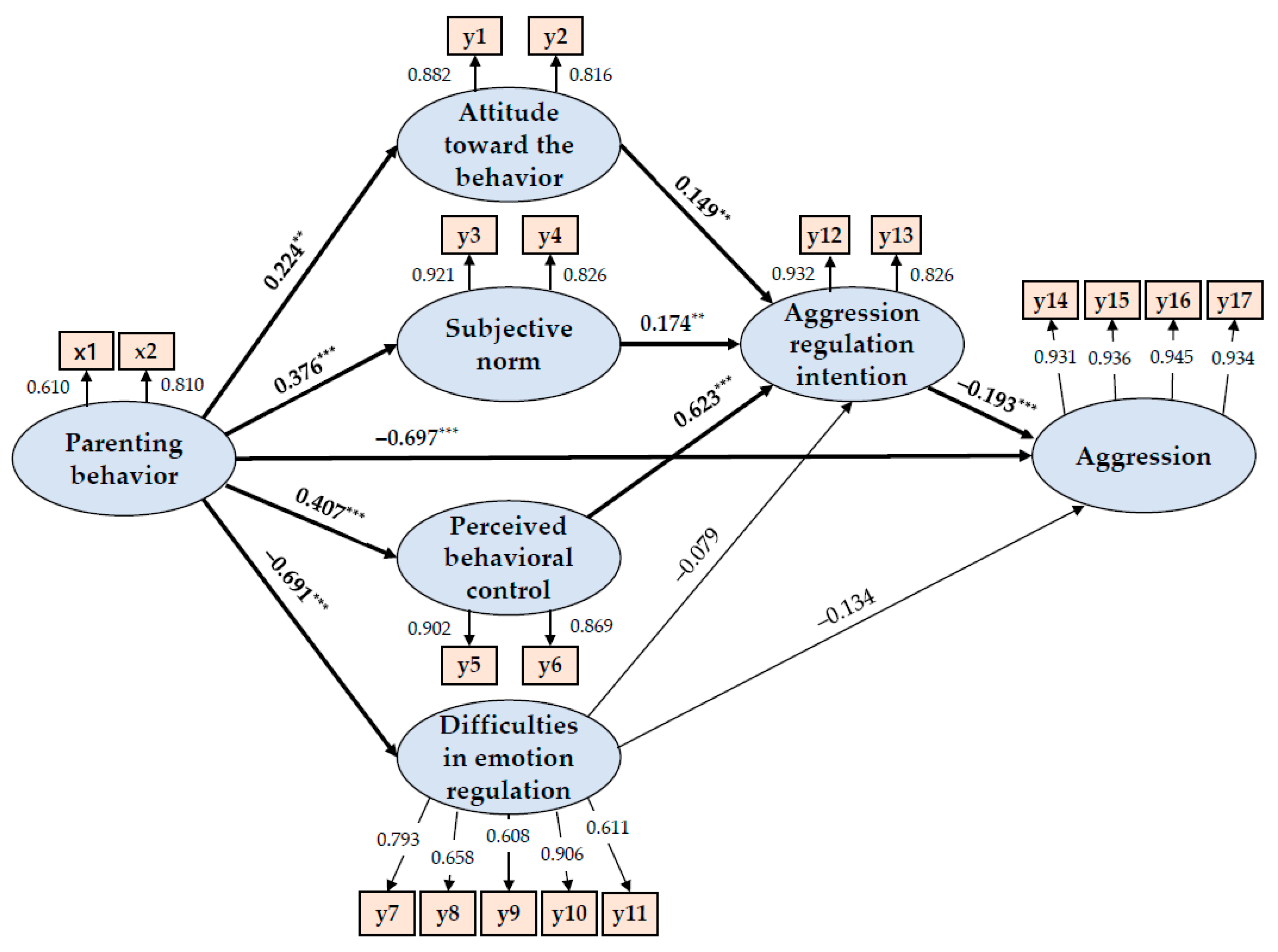
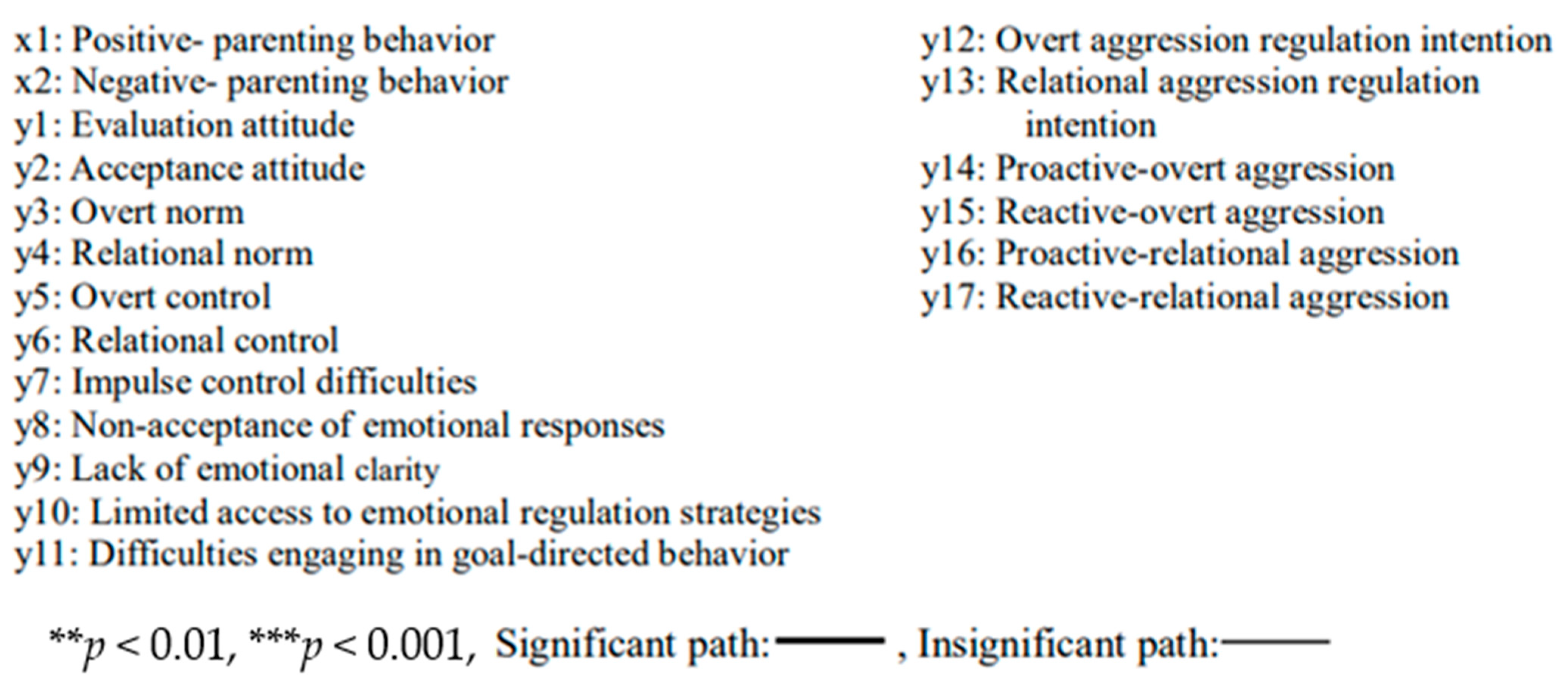
| (N = 310) | |||
|---|---|---|---|
| Characteristics | Categories | n (%) | |
| Grade | Middle school 1 | 241 | (77.7) |
| Middle school 2 | 69 | (22.3) | |
| Gender | Male | 116 | (37.4) |
| Female | 194 | (62.6) | |
| Religion | None | 163 | (52.6) |
| Christianity | 98 | (31.6) | |
| Catholic | 23 | (7.4) | |
| Buddhism | 21 | (6.8) | |
| Other | 5 | (1.6) | |
| Father’s job type | None (or house wife) | 40 | (12.9) |
| Office job | 26 | (8.4) | |
| Employee | 95 | (30.6) | |
| Professional position | 36 | (11.6) | |
| Seller, service | 36 | (11.6) | |
| Personal business | 55 | (17.8) | |
| Other | 22 | (7.1) | |
| Mother’s job type | None (or house wife) | 129 | (41.6) |
| Office job | 14 | (4.5) | |
| Employee | 51 | (16.5) | |
| Professional position | 23 | (7.4) | |
| Seller, service | 53 | (17.1) | |
| Personal business | 21 | (6.8) | |
| Other | 19 | (6.1) | |
| Family income | High | 85 | (27.4) |
| Average | 189 | (61.0) | |
| Low | 36 | (11.6) | |
| Latent Variables Measured Variables | Item No | Min | Max | M ± SD | Skewness | Kurtosis |
|---|---|---|---|---|---|---|
| Parenting behavior | 38 | 2 | 4.53 | 3.11 ± 0.34 | 0.526 | 1.417 |
| Positive parenting behavior | 19 | 1.42 | 5 | 3.67 ± 0.70 | −0.106 | −0.594 |
| Negative parenting behavior | 19 | 1.16 | 4.58 | 2.55 ± 0.64 | 0.174 | −0.281 |
| Attitude toward the behavior | 6 | 1 | 5 | 2.95 ± 0.98 | −0.019 | −0.305 |
| Evaluation attitude | 4 | 1 | 5 | 2.91 ± 1.0 | 0.045 | −0.531 |
| Acceptance attitude | 2 | 1 | 5 | 3.18 ± 0.97 | −0.201 | −0.082 |
| Subjective norm | 6 | 1 | 5 | 4.08 ± 0.76 | −0.719 | 0.308 |
| Overt norm | 4 | 1 | 5 | 4.14 ± 0.82 | −0.985 | 0.632 |
| Relational norm | 2 | 1 | 5 | 4.33 ± 0.82 | −1.187 | 0.933 |
| Perceived behavioral control | 6 | 1 | 5 | 3.76 ± 0.84 | −0.395 | −0.176 |
| Overt control | 4 | 1 | 5 | 3.74 ± 0.90 | −0.407 | −0.395 |
| Relational control | 2 | 1 | 5 | 3.79 ± 1.0 | −0.454 | −0.611 |
| Difficulties in emotion regulation | 34 | 1.15 | 3.94 | 2.67 ± 0.56 | −0.463 | −0.375 |
| Impulse control difficulties | 6 | 1 | 5 | 2.71 ± 0.78 | −0.156 | −0.2 |
| Lack of emotional awareness | 7 | 1 | 3.86 | 2.20 ± 0.66 | −0.021 | −0.918 |
| Non-acceptance of emotional responses | 7 | 1 | 5 | 2.74 ± 0.90 | −0.038 | −0.519 |
| Lack of emotional clarity | 3 | 1 | 5 | 2.69 ± 0.94 | 0.114 | −0.507 |
| Limited access to emotional regulation strategies | 7 | 1 | 5 | 2.75 ± 0.83 | −0.105 | −0.302 |
| Difficulties engaging in goal-directed behavior | 4 | 1 | 5 | 3.19 ± 0.77 | −0.435 | 0.344 |
| Aggression regulation intention | 6 | 1 | 5 | 3.75 ± 0.89 | −0.412 | −0.303 |
| Overt aggression regulation intention | 4 | 1 | 5 | 3.75 ± 0.90 | −0.353 | −0.484 |
| Relational aggression regulation intention | 2 | 1 | 5 | 3.73 ± 1.0 | −0.455 | −0.392 |
| Aggression | 16 | 1 | 4.25 | 1.69 ± 0.81 | 1.066 | −0.032 |
| Proactive-overt aggression | 4 | 1 | 4.25 | 1.62 ± 0.81 | 1.168 | 0.233 |
| Reactive-overt aggression | 4 | 1 | 4.75 | 1.76 ± 0.91 | 1.039 | 0.014 |
| Proactive-relational aggression | 4 | 1 | 4.75 | 1.63 ± 0.82 | 1.271 | 0.560 |
| Reactive-relational aggression | 4 | 1 | 4.25 | 1.75 ± 0.90 | 0.959 | −0.325 |
| Latent Variables Measured Variables | RW | SRW | S.E. | C.R | p | AVE | CR |
|---|---|---|---|---|---|---|---|
| Parenting behavior | 0.694 | 0.816 | |||||
| Positive parenting behavior | 1.000 | 0.602 | |||||
| Negative parenting behavior | 1.252 | 0.816 | 0.131 | 9.579 | <0.0001 | ||
| Attitude toward the behavior | 0.721 | 0.837 | |||||
| Evaluation attitude | 1.000 | 0.897 | |||||
| Acceptance attitude | 0.811 | 0.802 | 0.135 | 5.991 | <0.001 | ||
| Subjective norm | 0.827 | 0.905 | |||||
| Overt norm | 1.000 | 0.915 | |||||
| Relational norm | 0.899 | 0.831 | 0.064 | 13.946 | <0.001 | ||
| Perceived behavioral control | 0.793 | 0.885 | |||||
| Overt control | 1.000 | 0.907 | |||||
| Relational control | 1.075 | 0.865 | 0.059 | 18.181 | <0.001 | ||
| Difficulties in emotion regulation | 0.585 | 0.872 | |||||
| Impulse control difficulties | 1.000 | 0.819 | |||||
| Non-acceptance of emotional responses | 0.926 | 0.652 | 0.078 | 11.894 | <0.001 | ||
| Lack of emotional clarity | 0.810 | 0.549 | 0.083 | 9.710 | <0.001 | ||
| Limited access to emotional regulation strategies | 1.147 | 0.877 | 0.069 | 16.668 | <0.001 | ||
| Difficulties engaging in goal- directed behavior | 0.753 | 0.625 | 0.067 | 11.291 | <0.001 | ||
| Aggression regulation intention | 0.785 | 0.879 | |||||
| Overt aggression regulation intention | 1.000 | 0.931 | |||||
| Relational aggression regulation intention | 0.984 | 0.828 | 0.057 | 17.410 | <0.001 | ||
| Aggression | 0.897 | 0.972 | |||||
| Proactive-overt aggression | 1.000 | 0.937 | |||||
| Reactive-overt aggression | 1.100 | 0.917 | 0.037 | 29.776 | <0.001 | ||
| Proactive-relational aggression | 1.010 | 0.928 | 0.033 | 30.965 | <0.001 | ||
| Reactive-relational aggression | 1.116 | 0.942 | 0.034 | 32.857 | <0.001 | ||
| Variables | X1 | Y1 | Y2 | Y3 | Y4 | Y5 | Y6 |
|---|---|---|---|---|---|---|---|
| X1 | 1 | ||||||
| Y1 | 0.189 ** | 1 | |||||
| Y2 | 0.356 *** | 0.148 ** | 1 | ||||
| Y3 | 0.363 *** | 0.115 * | 0.531 *** | 1 | |||
| Y4 | −0.500 *** | −0.088 | −0.151 ** | −0.199 *** | 1 | ||
| Y5 | −0.405 *** | 0.231 *** | 0.513 *** | 0.677 *** | −0.234 *** | 1 | |
| Y6 | −0.560 *** | −0.118* | −0.345 *** | −0.397 *** | 0.359 *** | −0.407 *** | 1 |
| Model | CMIN(Χ2) | CMIN/DF | GFI | AGFI | IFI | CFI | SRMR | RMSEA | ||
|---|---|---|---|---|---|---|---|---|---|---|
| Χ2 | DF | p | ||||||||
| Excellent | ≥0.05 | ≤3 | ≥0.90 | ≥0.90 | ≥0.90 | ≥0.90 | ≤0.08 | 0~0.05 | ||
| Above average | ≥0.05 | ≤4 | ≥0.80 | ≥0.80 | ≥0.80 | ≥0.80 | ≤0.10 | 0.05~0.08 | ||
| Confirmatory factor analysis | 387.700 | 131 | p < 0.001 | 2.960 | 0.876 | 0.820 | 0.938 | 0.937 | 0.067 | 0.080 |
| Research model | 359.984 | 138 | p < 0.001 | 2.609 | 0.885 | 0.841 | 0.946 | 0.946 | 0.069 | 0.072 |
| Exogenous Variables | Endogenous Variables | Standardized Direct Effects β(p) | Standardized Indirect Effects β(p) | Standardized Total Effects β(p) | |
|---|---|---|---|---|---|
| (H1) | Parenting behavior | Attitude toward the behavior | 0.224 (0.002) ** | 0.224 (0.002) ** | |
| (H2) | Parenting behavior | Subjective norm | 0.376 (<0.001) *** | 0.376 (<0.001) *** | |
| (H3) | Parenting behavior | Perceived behavioral control | 0.407 (<0.001) *** | 0.407 (<0.001) *** | |
| (H4) | Parenting behavior | Difficulties in emotion regulation | −0.691 (<0.001) *** | −0.691 (<0.001) *** | |
| (H5) | Attitude toward the behavior | Aggression regulation intention | 0.149 (0.002) ** | 0.149 (0.002) ** | |
| (H6) | Subjective norm | 0.174 (0.005) ** | 0.174 (0.005) ** | ||
| (H7) | Perceived behavioral control | 0.623 (<0.001) *** | 0.623 (<0.001) *** | ||
| (H8) | Difficulties in emotion regulation | −0.079 (0.092) | −0.079(0.092) | ||
| (H9) | Parenting behavior | Aggression | −0.697 (<0.001) *** | 0.014 (0.884) | −0.683 (0.004) ** |
| (H10) | Difficulties in emotion regulation | −0.134 (0.148) | 0.015 (0.097) | −0.118 (0.242) | |
| (H11) | Aggression regulation intention | −0.193 (<0.001) *** | −0.193 (<0.001) *** | ||
| Exogenous Variables | Endogenous Variables | RW | SRW | S.E. | C.R. | p | SMC |
|---|---|---|---|---|---|---|---|
| Parenting behavior | Attitude toward the behavior | 0.495 | 0.224 | 0.157 | 3.145 | 0.002 ** | 0.05 |
| Parenting behavior | Subjective norm | 0.669 | 0.376 | 0.127 | 5.258 | <0.001 *** | 0.142 |
| Parenting behavior | Perceived behavioral control | 0.776 | 0.407 | 0.139 | 5.579 | <0.001 *** | 0.165 |
| Parenting behavior | Difficulties in emotion regulation | −0.996 | −0.691 | 0.126 | −7.917 | <0.001 *** | 0.477 |
| Attitude toward the behavior | Aggression regulation intention | 0.133 | 0.149 | 0.043 | 3.054 | 0.002 ** | 0.64 |
| Subjective norm | 0.192 | 0.174 | 0.068 | 2.82 | 0.005 ** | ||
| Perceived behavioral control | 0.642 | 0.623 | 0.068 | 9.484 | <0.001 *** | ||
| Difficulties in emotion regulation | −0.107 | −0.079 | 0.064 | −1.686 | 0.092 | ||
| Parenting behavior | Aggression | −1.225 | −0.697 | 0.213 | −5.762 | <0.001 *** | 0.505 |
| Difficulties in emotion regulation | −0.163 | −0.134 | 0.112 | −1.448 | 0.148 | ||
| Aggression regulation intention | −0.172 | −0.193 | 0.051 | −3.398 | <0.001 *** |
Disclaimer/Publisher’s Note: The statements, opinions and data contained in all publications are solely those of the individual author(s) and contributor(s) and not of MDPI and/or the editor(s). MDPI and/or the editor(s) disclaim responsibility for any injury to people or property resulting from any ideas, methods, instructions or products referred to in the content. |
© 2023 by the authors. Licensee MDPI, Basel, Switzerland. This article is an open access article distributed under the terms and conditions of the Creative Commons Attribution (CC BY) license (https://creativecommons.org/licenses/by/4.0/).
Share and Cite
Jang, S.; Ahn, H.Y. A Structural Model for Aggression in Middle School Students in Korea: Based on Ajzen’s Theory of Planned Behavior. Int. J. Environ. Res. Public Health 2023, 20, 1576. https://doi.org/10.3390/ijerph20021576
Jang S, Ahn HY. A Structural Model for Aggression in Middle School Students in Korea: Based on Ajzen’s Theory of Planned Behavior. International Journal of Environmental Research and Public Health. 2023; 20(2):1576. https://doi.org/10.3390/ijerph20021576
Chicago/Turabian StyleJang, Sook, and Hye Young Ahn. 2023. "A Structural Model for Aggression in Middle School Students in Korea: Based on Ajzen’s Theory of Planned Behavior" International Journal of Environmental Research and Public Health 20, no. 2: 1576. https://doi.org/10.3390/ijerph20021576
APA StyleJang, S., & Ahn, H. Y. (2023). A Structural Model for Aggression in Middle School Students in Korea: Based on Ajzen’s Theory of Planned Behavior. International Journal of Environmental Research and Public Health, 20(2), 1576. https://doi.org/10.3390/ijerph20021576






